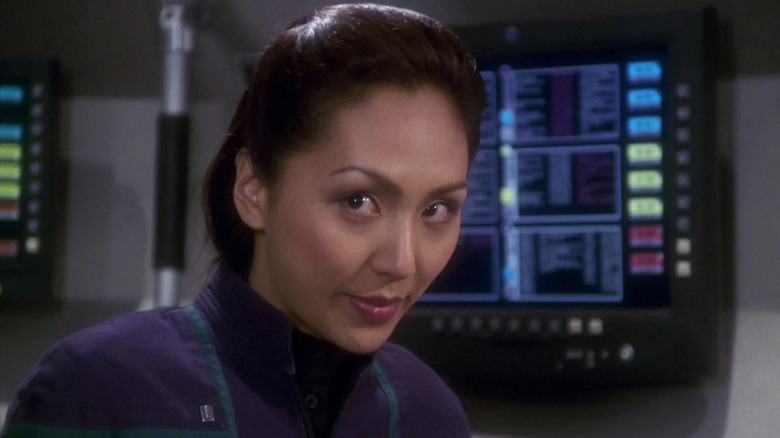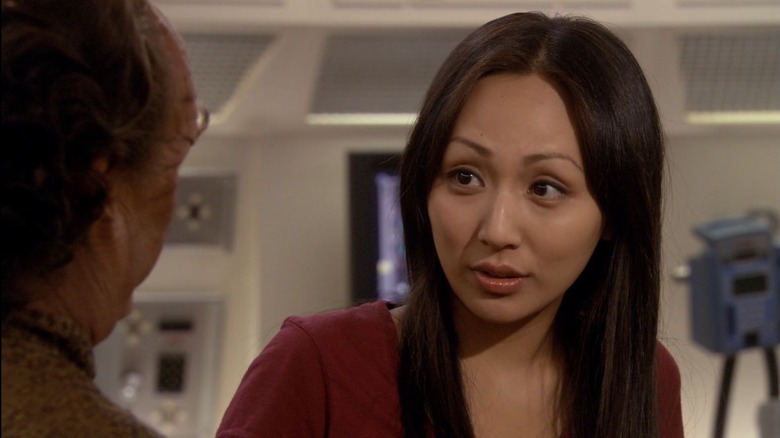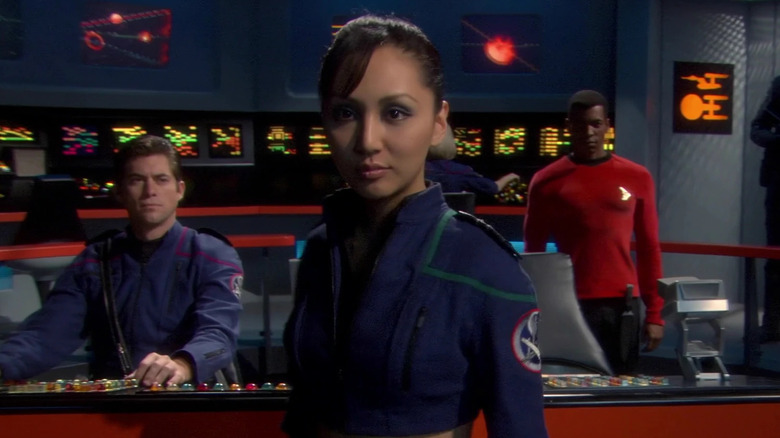Star Trek: Enterprise's Linda Park Wanted Ensign Sato To Have More Of These Types Of Stories
There is an irony to working on an ensemble series like "Star Trek," to be sure. On the one hand, every member of the crew is vital, and watching people work together — solving problems, and generally being resourceful and intelligent — is the central appeal of the show. But, because each show focuses on the crew of a ship or space station, responsibilities will have to be delegated, and those with bigger, more dramatic, more commanding jobs are ultimately going to command the most screen time. The captains on "Star Trek" shows tend to be their focus, with the lower-ranking crew members their support staff. As such, an ensign who translates alien languages — even if she's a member of the bridge crew — will by necessity only be included in stories about language translation. That means Ensign Hoshi Sato, played by actress Linda Park, was a vital member of the bridge crew ... who was often alone in a corner by herself.
"Star Trek: Enterprise" was set a century prior to the events of the 1966 "Star Trek," making for a world wherein common Trek tech was not common yet. There were no photon torpedoes yet, nor were there shields, food replicators, nor a universal translator. With no handy device that allowed for alien species to instantly communicate, the Enterprise relied on a language expert who could recognize alien syntax in an instant. That was Hoshi Sato. And while stories about translation did come up from time to time — a miscommunication between the Captain and a visiting alien dignitary resulted in a grave offense — Ensign Sato was more frequently left to study by herself.
In an interview with StarTrek.com, Park reveals that she felt lonely as Ens. Sato, largely because she was not allowed a great deal of inter-character interaction.
Isolated
Indeed, Hoshi Sato was so often written off to the side of the show's central action, one of her featured starring episodes, "Vanishing Point," was literally about her fading out of existence. Park addressed that:
"What I would have liked to have seen was more personal interaction. A lot of what Hoshi did in her side stories was very introverted and personal and isolated. Except for the Mirror Universe episodes, her personal scenes were usually isolated from the rest of the crew. She did have the one where she went off, that kind of Beauty and the Beast episode, and she was away from everybody else. 'Vanishing Point' was kind of in her own mind, and even then she couldn't really interact with anybody else because she was becoming a non-entity."
Park did like her co-stars — John Billingsley (who played Dr. Phlox) in particular. But she still laments how little time she got with any of them:
"I did get some interaction with Phlox, which I loved because I loved acting with John Billingsley and I loved being around him. We actually had a lot of great personal scenes, and that's my own personal taste. I love sci-fi and drama and comedy, but the unifying thread of the shows I like is that the personal stories are ingrained very richly into whatever else is going on."
Strong in the way Medea is strong
Park is correct, of course. "Star Trek," for many years, stuck to a very reliable writing formula of "A-plot/B -plot." In the A-plot, the main crisis would take place, meaning deeper ramifications for the central crew (Kirk is stuck on a planet, forced to fight in gladiatorial combat, for instance), while in the B-plot, a different character would be having a minor personal problem or crisis that either related to, or sprung from, the A-plot (Spock is back on the Enterprise, learning to be a better commander in Kirk's absence). This type of scriptwriting structure held strongest through the 1990s, and carried over into "Enterprise." Personal plots tying into the greater story. The structure wouldn't be shaken up until the premiere of "Star Trek: Discovery"
Park even had co-stars she would have preferred to interact with more, particularly Connor Trinneer, who played Charles "Trip" Tucker III, the ship's engineer, and Scott Bakula, who played Capt. Jonathan Archer. She didn't even have a particular story type in mind. She just liked acting with them:
"So I would have loved more interaction with Connor and Scott, more coloring outside the lines of the boss-employee relationship, whether it was conflict or romantic. I don't mean to the level of soap opera, but they're out in space and they're going to fight and have awkward moments."
Hoshi was allowed to have some moments, though. In a notable multi-part episode, audiences saw the Enterprise in the notorious Mirror universe (where everyone is evil), and Park was allowed to play an evil version of Hoshi who would eventually take over the Empire and become Empress of the Galaxy:
"I think it's well known that those are my favorite episodes. Who knows if it's just because if it was a taste of the different? Maybe if the reverse were true and I'd been playing the Mirror Hoshi, then when I did a Mirror episode playing a really good Hoshi I would have said, 'That was my favorite.' We always like what we don't get to do or what we don't have, because it's new. But I really did like being the aggressor and being more ... I don't want to say 'strong,' because Hoshi was strong in her own way. But the Mirror Hoshi was strong in the way that Medea is strong, in the way that Clytemnestra is strong, in this very archetypal, warrior-woman way. It's why I think a lot of us, when we're young, love to become actors, because we get to play out this primitive, only-children-dare-play-these-things way, and when we're older we wish we could play these kinds of mythical roles."
Since "Enterprise," Park's career has continued apace. She appeared in 13 episodes of the "Crash" TV series, and regularly appeared on Amazon's "Bosch." Her most recent role is the character of Joy on the animated series "Fairfax."


